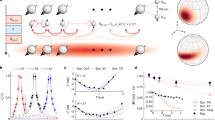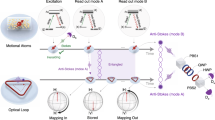Abstract
Strongly correlated quantum systems can exhibit exotic behaviour called topological order which is characterized by non-local correlations that depend on the system topology. Such systems can exhibit remarkable phenomena such as quasiparticles with anyonic statistics and have been proposed as candidates for naturally error-free quantum computation. However, anyons have never been observed in nature directly. Here, we describe how to unambiguously detect and characterize such states in recently proposed spin–lattice realizations using ultracold atoms or molecules trapped in an optical lattice. We propose an experimentally feasible technique to access non-local degrees of freedom by carrying out global operations on trapped spins mediated by an optical cavity mode. We show how to reliably read and write topologically protected quantum memory using an atomic or photonic qubit. Furthermore, our technique can be used to probe statistics and dynamics of anyonic excitations.
This is a preview of subscription content, access via your institution
Access options
Subscribe to this journal
Receive 12 print issues and online access
$209.00 per year
only $17.42 per issue
Buy this article
- Purchase on Springer Link
- Instant access to full article PDF
Prices may be subject to local taxes which are calculated during checkout





Similar content being viewed by others
References
Wen, X.-G. Quantum Field Theory of Many-Body Systems: From the Origin of Sound to an Origin of Light and Electrons (Oxford Univ. Press, Oxford, 2004).
Einarsson, T. Fractional statistics on a torus. Phys. Rev. Lett. 64, 1995–1998 (1990).
Das Sarma, S., Freedman, M., Nayak, C., Simon, S. H. & Stern, A. Non-abelian anyons and topological quantum computation. Preprint at <http://arxiv.org/abs/0707.1889> (2007).
Camino, F. E., Zhou, W. & Goldman, V. J. Realization of a Laughlin quasiparticle interferometer: Observation of fractional statistics. Phys. Rev. B 72, 075342 (2005).
Rosenow, B. & Halperin, B. I. Influence of interactions on flux and back-gate period of quantum Hall interferometers. Phys. Rev. Lett. 98, 106801 (2007).
Kitaev, A. Anyons in an exactly solved model and beyond. Ann. Phys. 321, 2–111 (2006).
Duan, L. M., Demler, E. & Lukin, M. D. Controlling spin exchange interactions of ultracold atoms in optical lattices. Phys. Rev. Lett. 91, 090402 (2003).
Micheli, A., Brennen, G. K. & Zoller, P. A toolbox for lattice-spin models with polar molecules. Nature Phys. 2, 341–347 (2006).
Brennen, G. K. & Pachos, J. K. Why should anyone care about computing with anyons? Proc. R. Soc. Lond. A 464, 1–24 (2007).
Pachos, J. K. The wavefunction of an anyon. Ann. Phys. 322, 1254–1264 (2007).
Zhang, C. W., Scarola, V. W., Tewari, S. & Das Sarma, S. Anyonic braiding in optical lattices. Proc. Natl Acad. Sci. USA 104, 18415–18420 (2007).
Mabuchi, H. & Doherty, A. C. Cavity quantum electrodynamics: Coherence in context. Science 298, 1372–1377 (2002).
Gupta, S., Moore, K. L., Murch, K. W. & Stamper-Kurn, D. M. Cavity nonlinear optics at low photon numbers from collective atomic motion. Phys. Rev. Lett. 99, 213601 (2007).
Colombe, Y. et al. Strong atom-field coupling for Bose–Einstein condensates in an optical cavity on a chip. Nature 450, 272–276 (2007).
Brennecke, F. et al. Cavity QED with a Bose–Einstein condensate. Nature 450, 268–271 (2007).
Cirac, J. I. & Zoller, P. Quantum computations with cold trapped ions. Phys. Rev. Lett. 74, 4091–4094 (1995).
Lu, C.-Y., Gao, W.-B., Guhne, O., Zhou, X.-Q. & Chen, Z.-B. Demonstration of fractional statistics of anyons in the Kitaev lattice-spin model. Preprint at <http://arxiv.org/abs/0710.0278> (2007).
Pachos, J. K. et al. Revealing anyonic statistics with multiphoton entanglement. Preprint at <http://arxiv.org/abs/0710.0895> (2007).
Han, Y. J., Raussendorf, R. & Duan, L. M. Scheme for demonstration of fractional statistics of anyons in an exactly solvable model. Phys. Rev. Lett. 98, 150404 (2007).
Briegel, H. J., Dur, W., Cirac, J. I. & Zoller, P. Quantum repeater: The role of imperfect local operations in quantum communication. Phys. Rev. Lett. 81, 5932–5935 (1998).
Jiang, L., Taylor, J. M., Khaneja, N. & Lukin, M. D. Optimal approach to quantum communication algorithms using dynamics programming. Proc. Natl Acad. Sci. USA 104, 17291–17296 (2007).
Kitaev, A. Y. Fault-tolerant quantum computation by anyons. Ann. Phys. 303, 2–30 (2003).
Dennis, E., Kitaev, A., Landahl, A. & Preskill, J. Topological quantum memory. J. Math. Phys. 43, 4452–4505 (2002).
Trotzky, S. et al. Time-resolved observation and control of superexchange interactions with ultracold atoms in optical lattices. Science 319, 295–299 (2008).
Scully, M. O. & Zubairy, M. S. Quantum Optics (Cambridge Univ. Press, Cambridge, 1997).
Cho, J. Addressing individual atoms in optical lattices with standing-wave driving fields. Phys. Rev. Lett. 99, 020502 (2007).
Gorshkov, A., Jiang, L., Greiner, M., Zoller, P. & Lukin, M. D. Coherent quantum optical control with sub-wavelength resolution. Phys. Rev. Lett. 100, 093005 (2008).
Wang, X. & Zanardi, P. Simulation of many-body interactions by conditional geometric phases. Phys. Rev. A 65, 032327 (2002).
Purcell, E. M. Spontaneous emission probabilities at radio frequencies. Phys. Rev. 69, 681 (1946).
Michler, P. et al. A quantum dot single-photon turnstile device. Science 290, 2282–2285 (2000).
Vandersypen, L. M. K. & Chuang, I. L. NMR techniques for quantum control and computation. Rev. Mod. Phys. 76, 1037–1069 (2004).
Brown, K. R., Harrow, A. W. & Chuang, I. L. Arbitrarily accurate composite pulse sequences. Phys. Rev. A 70, 052318 (2004).
Dusuel, S., Schmidt, K. P. & Vidal, J. Creation and manipulation of anyons in the Kitaev model. Preprint at <http://arxiv.org/abs/0802.0379> (2008).
Duan, L. M., Blinov, B. B., Moehring, D. L. & Monroe, C. Scalable trapped ion quantum computation with a probabilistic ion-photon mapping. Quant. Inf. Comput. 4, 165–173 (2004).
Lim, Y. L., Barrett, S. D., Beige, A., Kok, P. & Kwek, L. C. Repeat-until-success quantum computing using stationary and flying qubits. Phys. Rev. A 73, 012304 (2006).
Benjamin, S. C., Browne, D. E., Fitzsimons, J. & Morton, J. J. L. Brokered graph-state quantum computation. New J. Phys. 8, 141 (2006).
Jiang, L., Taylor, J. M., Sorensen, A. & Lukin, M. D. Distributed quantum computation based-on small quantum registers. Phys. Rev. A 76, 062323 (2007).
Arovas, D., Schrieffer, J. R. & Wilczek, F. Fractional statistics and the quantum Hall effect. Phys. Rev. Lett. 53, 722–723 (1984).
Freedman, M., Nayak, C. & Shtengel, K. Extended NMR model with ring exchange: A route to a non-abelian topological phase. Phys. Rev. Lett. 94, 066401 (2005).
Doucot, B., Feigel’man, M. V., Ioffe, L. B. & Ioselevich, A. S. Protected qubits and Chern-Simons theories in Josephson junction arrays. Phys. Rev. B 71, 024505 (2005).
Nielsen, M. A. & Chuang, I. Quantum Computation and Quantum Information (Cambridge Univ. Press, Cambridge, 2000).
Levitt, M. H. Spin Dynamics: Basics of Nuclear Magnetic Resonance (Wiley, Chichester, 2001).
Bacon, D. Operator quantum error-correcting subsystems for self-correcting quantum memories. Phys. Rev. A 73, 012340 (2006).
Milman, P. et al. Topologically decoherence-protected qubits with trapped ions. Phys. Rev. Lett. 99, 020503 (2007).
Levin, M. A. & Wen, X. G. String-net condensation: A physical mechanism for topological phases. Phys. Rev. B 71, 045110 (2005).
Hastings, M. B. & Wen, X.-G. Quasiadiabatic continuation of quantum states: The stability of topological ground-state degeneracy and emergent gauge invariance. Phys. Rev. B 72, 045141 (2005).
Aguado, M., Brennen, G. K., Verstraete, F. & Cirac, J. I. Creation, manipulation and detection of anyons in optical lattices. Preprint at <http://arxiv.org/abs/0802.3163> (2008).
Grier, D. G. A revolution in optical manipulation. Nature 424, 810–816 (2003).
Porto, J. V., Rolston, S., Tolra, B. L., Williams, C. J. & Phillips, W. D. Quantum information with neutral atoms as qubits. Phil. Trans. R. Soc. Lond. A 361, 1417–1427 (2003).
Bullock, S. S. & Brennen, G. K. Qudit surface codes and gauge theory with finite cyclic groups. J. Phys. A 40, 3481–3505 (2007).
Acknowledgements
We gratefully acknowledge conversations with H. P. Buchler, S. Dusuel, M. Greiner, L. Ioffe, A. Peng, A. M. Rey and J. Vidal. Work at Harvard is supported by NSF, ARO-MURI, CUA, DARPA, AFOSR and the Packard Foundation. Work at Innsbruck is supported by the Austrian Science Foundation, the EU under grants OLAQUI, SCALA, and the Institute for Quantum Information.
Author information
Authors and Affiliations
Corresponding author
Supplementary information
Supplementary Information
Supplementary Information and Supplementary Figures 1–2 (PDF 659 kb)
Rights and permissions
About this article
Cite this article
Jiang, L., Brennen, G., Gorshkov, A. et al. Anyonic interferometry and protected memories in atomic spin lattices. Nature Phys 4, 482–488 (2008). https://doi.org/10.1038/nphys943
Received:
Accepted:
Published:
Issue Date:
DOI: https://doi.org/10.1038/nphys943
This article is cited by
-
Many-body quantum chaos in stroboscopically-driven cold atoms
Communications Physics (2023)
-
A unidirectional on-chip photonic interface for superconducting circuits
npj Quantum Information (2020)
-
Experimental preparation of topologically ordered states via adiabatic evolution
Science China Physics, Mechanics & Astronomy (2019)
-
Hardware-efficient fermionic simulation with a cavity–QED system
npj Quantum Information (2018)
-
Four-body ring-exchange interactions and anyonic statistics within a minimal toric-code Hamiltonian
Nature Physics (2017)



